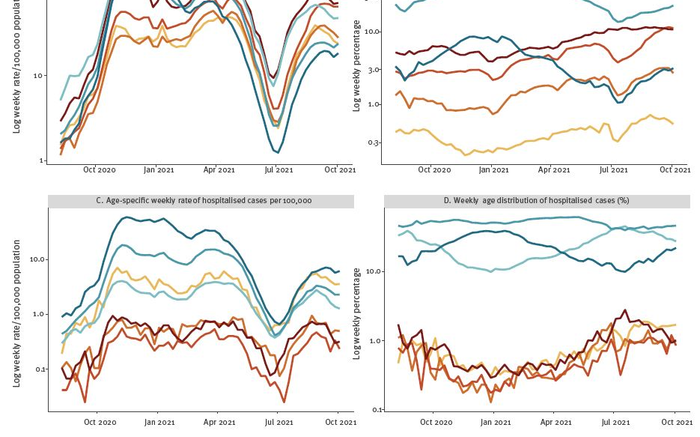Pooled weekly notification rates increased sharply in all age groups from July 2021. Researchers observed concomitant rises in hospitalization rates in all age groups, but starting from, and reaching, much lower levels in children aged 1–17 years than in adults or children younger than 1 year. Since January 2021, children have represented an increasing proportion of notified cases and hospital admissions. Courtesy of Eurosurveillance
In their rapid communication ‘COVID-19 trends and severity among symptomatic children aged 0–17 years in 10 European Union countries,’ Bundle, et al. report on the burden and severity of notified symptomatic COVID-19 cases among children in the European Union (EU). They estimate the risks of severe outcomes among the 820,404 symptomatic pediatric COVID-19 cases that were reported by 10 EU countries during that period.
The authors observed that since the start of 2021, hospital admission and notifications of COVID-19 among children have been increasing. Pooled weekly case notification and hospitalization rates increased sharply in all age groups (children as well as adults) from July 2021 onwards.
Among the more than 820,000 notified COVID-19 cases among children from the 10 reporting countries, 9,611 (1.2%) were hospitalized, 640 (0.08% of all cases, 6.7% of hospitalized cases) were admitted to an intensive care unit (ICU) and 84 (0.01%) children died.
Based on the available data, the youngest age groups (0 to 2 months) carried the highest risk of being hospitalized - with point estimates that decreased with increasing age up to 9 years of age and then increased again with each year from 12 to 17 years. Results for periods coinciding with dominance of the Delta variant were consistent with the full study period, although hospitalization was more common among children younger than 1 year (14.7% Delta vs 13.1% full period; p < 0.01).
The risk of a severe COVID-19 outcome was higher among children with existing underlying health conditions such as cancer or diabetes. After controlling for age group, reporting country, four time periods and sex, adjusted odds of hospitalization, ICU admission and death were seven, nine and 27 times higher, respectively, among cases with at least one comorbidity compared with children that had none. However, the vast majority of hospitalized children with COVID-19 (83.7%) had no reported comorbidity. According to the authors, this could demonstrate ‘a potential population-level impact of high levels of community transmission leading to large numbers of hospital admissions among healthy children’.
The authors conclude that "Case notification and hospital admission rates among children rise as overall transmission increases, but [that] most children with symptomatic COVID-19 have a very low risk of death or hospitalization." Based on the presented data from the study, for every 10,000 symptomatic pediatric cases, around 117 were hospitalized and eight required ICU admission or respiratory support.
As only 15.2% (range: 1.0–29.0%) of children younger than 18 years in the EU and European Economic Area (EEA) had been fully vaccinated against COVID-19 by the end of November 2021 (week 47), The authors note that large numbers of unvaccinated children will likely be exposed to the virus during current high COVID-19 incidence in many parts of the EU/EEA which could lead to increases in the absolute numbers of children, both with and without underlying health conditions, that experience severe COVID-19 outcomes.
According to the authors, "Preventive measures to reduce transmission and severe outcomes in children remain critical, as does the submission of timely, complete surveillance data to facilitate assessment of severity following the emergence of new variants."
